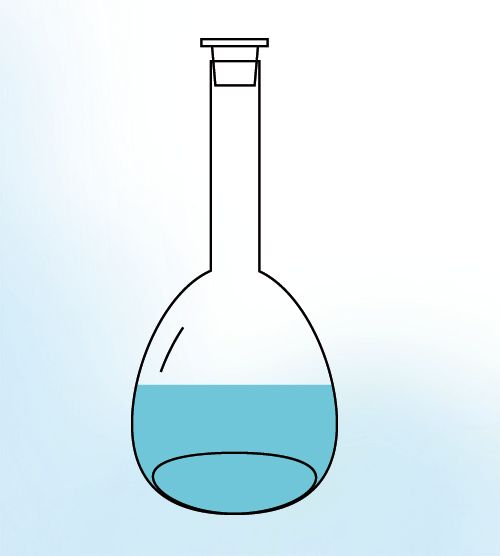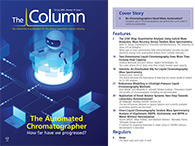Solvents: An Overlooked Ally for Liquid Chromatography–Mass Spectrometry
Liquid chromatography–mass spectrometry (LC–MS) platforms are continually developing to offer improved sensitivity to meet the analytical demands of today’s laboratories. However, choosing an inappropriate solvent can significantly undermine the quality of results, even when using the most advanced technology; a high-purity mobile phase with excellent batch-to-batch consistency is essential for reliable and reproducible results. This article discusses the importance of selecting the correct grade of solvent for LC–MS analyses and some of the challenges arising from an insufficiently pure mobile phase.
Photo Credit: Rattiya Thongdumhyu/Shutterstock.com

Liquid chromatography–mass spectrometry (LC–MS) platforms are continually developing to offer improved sensitivity to meet the analytical demands of today’s laboratories. However, choosing an inappropriate solvent can significantly undermine the quality of results, even when using the most advanced technology; a high-purity mobile phase with excellent batch-to-batch consistency is essential for reliable and reproducible results. This article discusses the importance of selecting the correct grade of solvent for LC–MS analyses and some of the challenges arising from an insufficiently pure mobile phase.
Analytical laboratories currently face ever-growing demands for increased sample throughput and faster turnaround times. At the same time, advances in technology enable analytes to be detected at lower concentrations than ever before, presenting a challenge to analysts striving to maintain the accuracy and reproducibility of their results. Liquid chromatography–mass spectrometry (LC–MS) has become the technique of choice for many laboratories working in a broad range of scientific fields, including pharmaceutical, food and beverage, forensics and toxicology, environmental monitoring, and R&D. Its popularity is largely because of its low limits of detection for both qualitative and quantitative analyses. As instrument manufacturers continue to improve the sensitivity and mass accuracy of their
LC–MS systems, analyte detection limits are set to decrease even further, highlighting the need to ensure that any potential interferences are reduced as much as possible.
The Impact of Solvent Choice on Potential Interferences
Choosing an ultrapure solvent is critical to reliable and reproducible instrument operation and high-quality results. However, the choice of available solvents can be overwhelming, sometimes creating the temptation to cut corners. For example, while it is obvious that a laboratory-grade solvent is unsuitable for highly sensitive analytical techniques, people still wonder if choosing a high performance liquid chromatography (HPLC)-, rather than
LC–MS-, grade solvent makes any difference. In fact, the consequences can be considerable, because LC–MS-grade solvents will have undergone additional purification steps to remove trace metals and other impurities that could potentially interfere with the analysis.
Purification Methods
Purification methods will vary between manufacturers, and some will be more effective than others. In many cases, solvents are batch selected, with suppliers testing each batch for suitability on delivery before repackaging it into smaller containers for laboratory use. However, while the solvent may be optically pure and appear clean to the naked eye, it is likely that a considerable non-volatile residue will have accrued during shipping. This can be problematic, potentially causing blockages in HPLC lines, pumps, and columns. In contrast, extensive purification by chemical treatment and glass distillation significantly reduces impurities and enhances batchâtoâbatch consistency, reducing unnecessary instrument downtime and the need to troubleshoot ghost peaks.
The Ideal Solvent
Ideally, the solvent should have been functionally tested to ensure that it is suitable for use as a mobile phase. Typically, functional testing is done using the reserpine test. A reserpine standard of a specified concentration is run in both electrospray (ESI) and atmosphericâpressure chemical ionization (APCI) modes to evaluate the presence of any impurities and establish that the signal intensity to background noise ratio meets the requirements for successful LC–MS analyses.
Particulates can block inlet and in-line filters and LC columns-reducing column life span and causing costly unscheduled downtime-so it is important to select LC–MS solvents that have been prefiltered with a 0.2 μm (or smaller) filter to eliminate these impurities. This is especially important for users of ultrahigh-performance liquid chromatography (UHPLC)–MS systems, which use narrower bore columns and smaller particle sizes.
Solvent Choice and Background Noise
LC–MS systems may be equipped with diode-array detection, and a stable, flat baseline with minimal drift is essential. The solvent should be free from impurities showing UV–vis absorbance, such as organic acids. Similarly, solvents offering the lowest possible mass background are crucial for trace MS analyses, maximizing the signal intensity at low analyte concentrations. Contaminants-such as plasticizers or phthalates-can be introduced during the manufacturing process, for example, from production area surfaces and equipment, and manufacturers must be vigilant and implement measures to ensure these are tightly controlled.
The Impact of Trace Metals on MS Spectra
The formation of metal adduct ions is a particular problem for ESI analyses. Typically, this occurs with alkali metal ions, such as sodium and potassium, although adduct ions may also arise from other species, from salts such as ammonium or chloride, or even solvent molecules. Adduct ions in APCI must be volatile and so, while ammonium, chloride, or water adducts can arise, metal ion adducts do not.
The formation of adduct ions has a twofold effect. First, they lead to complex MS spectra and a reduction in the signal intensity to background noise ratio, resulting in less sensitivity. Second, adduct ion formation is inconsistent from run to run, likely leading to a decrease in the accuracy and reproducibility of the analytical data generated. To reduce this effect, it is vital to choose a solvent that has undergone stringent testing for metal ions, as well as other ionic species that could cause ion suppression.
Best Practices
Correct storage and handling is essential to maintaining the quality of a solvent once it is in use, because it is easy to forget that contaminants can be absorbed from the environment. Analysts should also take care not to inadvertently introduce contamination when handling and preparing mobile phases, remembering that, for example, plasticizers can leach from plastic gloves. In addition, using pipettes to add reagents such as trifluoracetic, acetic, or formic acids to the mobile phase can be a potential source of contamination. Ideally, different sets of pipettes should be used to prepare the mobile phase and the stock solutions for analysis.
LC–MS mobile phases should be stored on the instrument for the minimum amount of time, and solvent reservoirs should always be capped. The choice of storage container should also be considered carefully. For example, plastic bottles leach plasticizers into aqueous solvents over time, while glass containers release ionic contaminants and organics, although at a lower level than their plastic counterparts. Generally, this makes glass reservoirs-preferably borosilicate glass-the material of choice.
Aqueous mobile phases and water are prone to microbial growth during storage, which can cause blockages and result in spurious peaks. Regular replacement of the mobile phase, accompanied by flushing the LC system to ensure the removal of any residual solvent from the previous batch, will help to reduce the likelihood of microbial contamination. Equally importantly, analysts should resist the temptation to “top up” solvent reservoirs, rather than replacing them with a fresh bottle of mobile phase. And, of course, storage reservoirs should be thoroughly cleaned before reuse.
Conclusions
State-of-the-art LC–MS instruments demand mobile phases prepared from ultrapure solvents to achieve the best possible sensitivity, accuracy, and reproducibility. While this begins with careful choice of manufacturer, laboratories need to follow best practice to avoid contamination during the preparation and use of mobile phases. By using LC–MS-grade solvents and ensuring that mobile phases are correctly handled and stored in the laboratory, analysts can be certain of getting the most out of their LC–MS systems.
Anthony Lenk is the Director of Romil Ltd.
E-mail:pure.chemistry@romil.comWebsite:http://www.romil.com/

Common Challenges in Nitrosamine Analysis: An LCGC International Peer Exchange
April 15th 2025A recent roundtable discussion featuring Aloka Srinivasan of Raaha, Mayank Bhanti of the United States Pharmacopeia (USP), and Amber Burch of Purisys discussed the challenges surrounding nitrosamine analysis in pharmaceuticals.
Advances in Non-Targeted Analysis for PFAS in Environmental Matrices
March 27th 2025David Megson from Manchester Metropolitan University in Manchester, UK, spoke to LCGC International about the latest developments in non-targeted analysis (NTA) of per- and polyfluoroalkyl substances (PFAS) in environmental matrices based on a recent systematic review paper he has collaboratively published (1).














